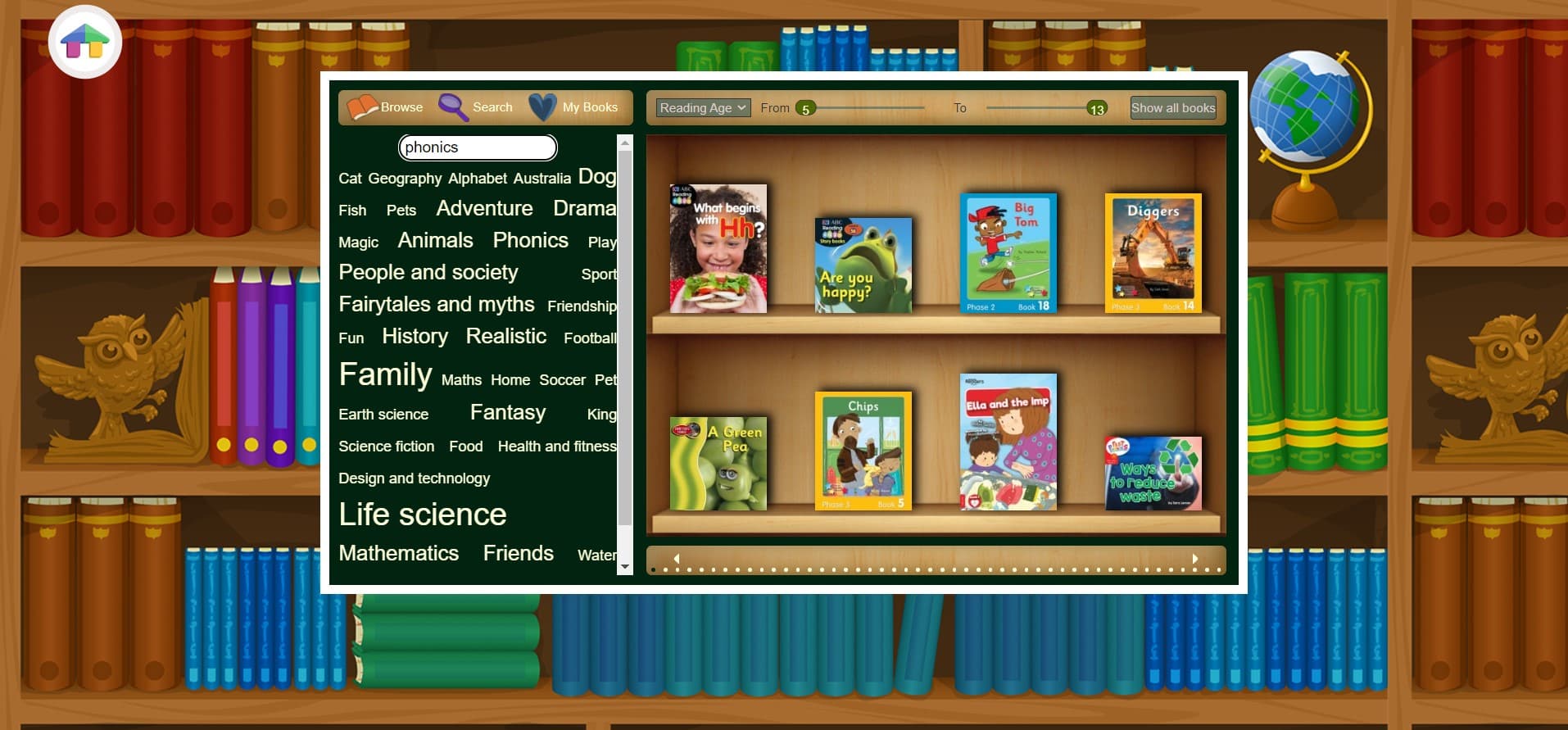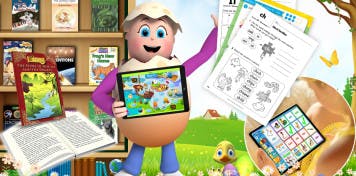


How to Create the Ultimate Homeschool Room for Early Readers

Create a homeschool room that supports early reading skills and nurtures a passion for learning with Reading Eggs. Free trial
Nurturing an early love of reading is the strongest indicator of academic success and homeschooling presents a unique opportunity to foster this passion in children. Creating a supportive, appealing homeschool room for learning early reading skills is crucial to the success of kids.
Homeschoolers have the advantage of being able to customize a space that complements their child’s learning style anywhere both in and outdoors. In this article, we will discuss what you should include in your homeschool spaces to help your child develop strong early reading skills.
Designing a safe, comfy homeschool room that promotes early reading
1. Choose the best homeschool room location
Firstly, it's essential to determine the best location for your homeschool room. Ideally, the learning area should be in a quiet, low-traffic spot in the home where your child can focus on learning without distractions. You don’t have to set up a formal classroom but opt for a workspace that complements your family’s needs.
2. Which furniture do you need for a homeschool room?
If homeschooling multiple children at once, choose a large table with plenty of elbow room and space for everyone’s workbooks or devices. Think of how you’ll fit into the mix with space to sit beside a child if needed. Comfortable chairs will help your child stay on task longer. Restless learners can benefit from time sitting on exercise balls, seat cushions or bean bags to help them focus. A bookcase or shelf that is easily accessible to your child can help encourage them to read more.
3. Creating a cozy and safe homeschool haven
Consider factors such as natural and artificial light, as it can help create a calm, optimum environment for reading and literacy lessons. Also, flooring that is spill-proof, not slippery and easy to clean.
4. How to create a homeschool reading nook
Make a comfy reading corner with soft seating like a bean bag or cushions. Add blankets and pillows to encourage your child to use the space and enjoy reading. You can also encourage your child to personalize their reading space with their favourite books, making the space more inviting.
5. How to add colour and interest to your homeschool room
Ensure your homeschool room is visually engaging, with academic decorations such as the alphabet or word posters. Include artwork related to books or reading to make the space more inviting.
6. Setting up a homeschool library
Setting up a home library is an important aspect of creating a supportive homeschool environment to encourage early reading skills. Having a selection of books readily available can make it easier for your child to develop a love for reading. It's essential to choose and organize books for different reading levels and categories to ensure your child has access to books that are appropriate for their reading level and interests.

Immerse your homeschool in a world of fun and learning with Reading Eggs! Use captivating reading lessons, interactive literacy activities and access an extensive online library boasting over 4,000 books. Free trial.
7. Using an e-library for homeschooling
If you don’t have much space for physical books, you can also use technology to supplement the home library. E-books can be a great way to keep a variety of reading materials at your fingertips without cluttering up your home. Online libraries offer a wide selection of books for different reading levels, making it easy to find books that are appropriate for your child.
Homeschool today with a Reading Eggs FREE trial
Support your child's early reading skills in your homeschool room with the multi-award winning Reading Eggs program. Full of fun, interactive lessons, games and over 500 printables. Plus, access to over 4,000 e-books for your homeschool library.
Creating an outdoor homeschool space for teaching reading skills
One of the greatest benefits of homeschooling is that you can create a variety of learning spaces that will foster a love of reading. Mix it up by taking your homeschool room to the backyard, the park or even on the go.
8. Choose the perfect outdoor homeschool reading spot
Make your child’s favorite tree a space they associate with reading time. You could also string up a hammock, set up a picnic rug or scatter cushions.
9. Outdoor homeschool furniture set-up tips
If you’re taking writing activities or worksheets for your child to complete outside, make sure you don’t have a table with holes or an uneven surface, as this makes it more difficult to write.
10. Outdoor homeschool activity ideas
There are countless reading activities that can be customized for diverse environments and learning styles. Outdoor literacy games allow children to get physical, recalibrate and focus if they’re starting to get restless from sitting at a desk.
Here are some outdoor homeschool ideas for reading

Activities that involve matching letter sounds to objects or pictures can be great for visual learners. Give your child alphabet cards and ask them to select objects that start with certain letters, e.g., ‘t’ for tree. There are also many resources available online, such as phonic games and printable worksheets.

Expand your child's vocabulary with engaging activities like word hunts and word association games. Perfect for auditory learners, these exercises will enhance their language skills while making learning a joyful experience.

Incorporating literacy into everyday activities, such as grocery shopping. You can do this by having your child sound out letters, read labels or signs and make a shopping list.
Setting up a homeschool technology learning area
Create a welcoming and safe homeschool room dedicated to honing literacy skills using digital devices. Including computers or tablets as valuable tools for learning is advantageous in today's world and in your homeschool room. It's important to build proficiency in these technologies as reading online is likely to be a part of your child's ongoing education and future work life.
11. Designing a homeschool technology workspace
Position computers in a way that’s optimal for your child to avoid eye strain and tiredness which can affect focus. Set up screens at your child’s eye level and make sure they have a supportive office chair that’s suitable for their size. If your child likes to use devices you can double up their reading nook as a technology space. Some families invest in lap desks for use anywhere, especially for noisier activities. Invest in headphones to keep children from distracting each other.
12. Crafting a safe, engaging online homeschool space
Independent learning is an important skill, especially when you have multiple children to teach. Make sure to position your child’s computer station where they are comfortable and learning safely. It’s best if you can check if your child is staying on task and not surfing inappropriate websites. Keep them engaged with fun reading games and literacy activities.
13. Choosing safe educational websites and apps
Make sure to stick with accredited and safe online reading programs for children such as Reading Eggs. Educational apps and e-books can all be used to supplement offline reading and provide positive screen time for your child.
With the right balance of technology and offline reading, you can help your child develop strong reading skills that will benefit them for a lifetime. Creating a supportive reading environment is crucial for early literacy development and homeschooling offers the optimal opportunity to do so.
By implementing some of the ideas suggested, you can design the perfect homeschool room for your child’s early learning needs. With a little creativity and planning, you can create a homeschool environment that not only supports early reading skills but also instills a lifelong love of reading that helps your child build a strong foundation for academic success.
Homeschool today with a Reading Eggs FREE trial
Support your child's early reading skills in your homeschool room with the multi-award winning Reading Eggs program. Full of fun, interactive lessons, games and over 500 printables. Plus, access to over 4,000 e-books for your homeschool library.






